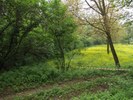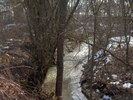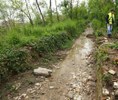The vegetation
Because of its location, the project area shows strong differences in vegetation coverage with quite high levels of naturality in the Southern part and completely transformed area in the plain part. The line of passage between the two ecological situations can be identified with the so-called “pedemontana”, the line running along the foothill.
 In the hill belt, the actual vegetation can be framed in the sub-mediterranean Oak-woods dominated by the Pubescent Oak (Quercus pubescens) on basic or neutral soils or by Turkish Oak (Quercus cerris) or Sessile oak (Quercus petraea) on sandy (acid) ones.
In the hill belt, the actual vegetation can be framed in the sub-mediterranean Oak-woods dominated by the Pubescent Oak (Quercus pubescens) on basic or neutral soils or by Turkish Oak (Quercus cerris) or Sessile oak (Quercus petraea) on sandy (acid) ones.
This scheme is useful to understand and evaluate the vegetational actual coverage, although more or less deeply modified by human activities.
A typical secundary forest is the Chestnut wood that has been planted in ancient times on sandy soils where natural Oak woods were growing.
Grasslands and cultivations, that are more or less wide, come all from substitution of the original forest coverage. 
In the plain the original forest was also an Oak wood with Turkish and Sessile Oaks in the highest parts at the top of terraces; in these localisation was present also a vegetation of acid soils, with Tree Heath (Erica arborea) and Heather (Calluna vulgaris) as characteristic species.
In wet places this kind of wood was enriched by the presence of Pedunculate Oak (Quercus robur).
To-day this belt is completely occupied by civil and industrial settlements and by agricultural activities.
By consequence the vegetation is that of human settlements, characterized by short-cycle annual plants (therophytes), with a strong presence of alien plants either introduced or natural. The vegetation is mainly ruderal with low levels of naturality.
 The thin network of small rivers and streams is the natural connection between these two areas and plays an important role in the ecological network.
The thin network of small rivers and streams is the natural connection between these two areas and plays an important role in the ecological network.
The riverine environments in the project area have been severely reduced in the past and the vegetation coverage is fragmented and shows a quite low quality in composition and structure.
In spite of these problems some tracts of good quality are present and, in general, the potential dynamics can be helpful toward the reconstruction of near-natural wood vegetation.
